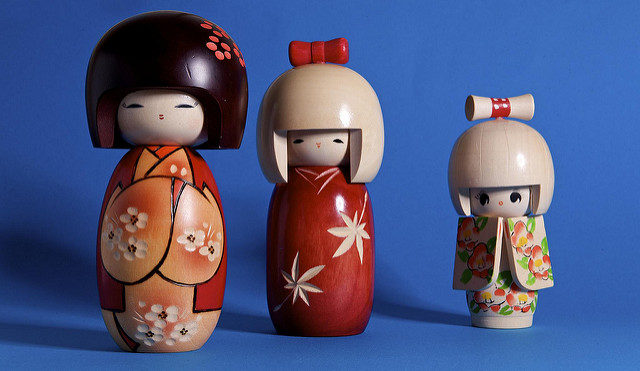Kokeshi are Japanese dolls from the Tohoku region in Northern Japan. These handmade wooden dolls have a colorful history and controversial reputation.
They were traditionally made as guardians of children but later became popular amongst Japanophiles and collectors. Kokeshi are thought to date back to the early 19th-century and they were produced by kijishi, woodworkers at the Shinichi Shuraku, near the Togatta Onsen in Zao.


According to other sources, it is said that they were originally sold to visitors in the Tohoku region during the Edo Period (1600-1868). The origin of the name ‘kokeshi’ is unclear; some historians suggest that the name is a combination of names given to the dolls by their manufacturers.
The traditional kokeshi is painted in black, red, and yellow and covered with wax. They are simple in shape with round heads and cylindrical limbless bodies and are made by the model of Naruko style or Tsuchiyu style.


Today, there are different designs of the kokeshi dolls with a more rounded shape that their traditional counterparts, with different facial expressions and richer colors. The result of these innovative techniques creates an attractive and beautiful doll. They are often sold as gifts to celebrate a special occasion.
These modern dolls are called creative kokeshi and have been developing as an art form since the Second World War. These dolls are not particular to one region of Japan. Most of the creative kokeshi can be found in the cities while traditional Kokeshi artists are located in more rural areas.

The Kokeshi dolls are made from the cherry or Mizuki tree which is literally translated as the “water tree”. The wood is left outdoors to season for one to five years before it can be used. The seasoned wood than is cut into small pieces in the size of kokeshi doll and it is roughly shaved and rounded off. Each piece is then turned on a potter’s wheel and cut to shape with a plane.


The kokeshi is still believed to be a lucky charm doll so people keep kokeshi to protect their homes. There are 11 types of Kokeshi dolls and the most common is the Naruko doll made in the Miyagi Prefecture.
They are celebrated as one of Japan’s folk arts and can be found in antique fairs or flea markets. Made in many different styles these Japanese dolls became popular around the world.
No comments:
Post a Comment